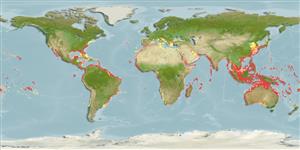分类 / Names
俗名 | 同种异名 | Catalog of Fishes(属, 种) | ITIS | CoL | WoRMS | Cloffa
Elasmobranchii
板鳃亚纲 (鲨鱼与 鱼) (sharks and rays) >
Carcharhiniformes (Ground sharks)
白眼鮫目 (Ground sharks) >
Carcharhinidae (Requiem sharks)
白眼鮫科 (Requiem sharks)
Etymology: Carcharhinus: karcharos (Gr.), sharp or jagged; rhinus, an ancient name for sharks, from rhine (Gr.), rasp, both words alluding to a shark's jagged, rasp-like skin. (See ETYFish); limbatus: Latin for edged or bordered, referring to black-edged fins [authorship often attributed to Müller & Henle, who published Valenciennes’ description]. (See ETYFish).
Environment: milieu / climate zone / depth range / distribution range
生态学
海洋; 半咸淡水 礁区鱼类; 非产卵性溯降河的 (Ref. 51243); 深度上下限 0 - 140 m (Ref. 106604), usually 0 - 30 m (Ref. 55184). 亞熱帶的; 45°N - 38°S, 180°W - 180°E (Ref. 55184)
Cosmopolitan. Western Atlantic: Nova Scotia, Canada to Brazil (Ref. 26340). Eastern Atlantic: Senegal to Democratic Republic of the Congo, Madeira, the Canary Islands, and Mediterranean (Ref. 244). Indo-Pacific: Persian Gulf (Ref. 68964), Red Sea, Madagascar and South Africa to China, Australia, Tahiti, Marquesas, and Hawaii. Eastern Pacific: Baja California, Mexico to Peru, including the Galapagos Islands.
四海為家的人。 西大西洋: 加拿大的新斯科舍省到巴西.(參考文獻 26340) 東大西洋: 塞內加爾到剛果,馬得拉群島,加納利群島與地中海。 印度-太平洋: 紅海,馬達加斯加與南非至中國,澳洲,大溪地島,馬可薩斯島與夏威夷。 東太平洋: 墨西哥的下加利福尼亞到祕魯, 包括加拉巴哥群島。
Length at first maturity / 大小 / 重量 / 年龄
Maturity: Lm 165.4, range 120 - 194 cm
Max length : 286 cm TL 雄鱼/尚未辨别雌雄; (Ref. 106604); common length : 150 cm TL 雄鱼/尚未辨别雌雄; (Ref. 9253); 最大体重: 122.8 kg (Ref. 4699); 最大年龄: 12 年 (Ref. 244)
背棘 (总数): 0; 背的软条 (总数): 0; 臀棘 0; 臀鳍软条: 0. A stout shark with a long, narrow, pointed snout, long gill slits and erect, narrow-cusped upper teeth; first dorsal fin high; no interdorsal ridge (Ref. 5578). Dark grey, ashy blue or dusky bronze on back, belly white or yellowish white; a dark band extending rearward along each side to about over origin of pelvic fin; tips of pelvic fins with a persistent black spot; tips of dorsal fins, pectoral fins, anal, and lower lobe of caudal fin usually black or dusky in young individuals, fading with growth (Ref. 9997).
一矮胖的鲨鱼有一个长的,狭窄的,和尖的吻又长的鳃缝与直立的, 细尖的上颚齿; 第一背鳍很高; 没有间背脊.(参考文献 5578) 深灰色的,灰蓝色或暗青铜色背面, 腹部白色或黄白色; 一个延伸的深色条纹向后沿着两边到大约腹鳍的起源上面; 腹鳍顶端具有一个持续的黑色斑点; 背鳍顶端,胸鳍, 肛门的, 与尾鳍的低叶通常黑色或暗色的在被随着成长消失的幼鱼中.(参考文献 9997)
An inshore and offshore shark found on or adjacent to continental and insular shelves (Ref. 244). Often off river mouths and estuaries, muddy bays, mangrove swamps, lagoons, and coral reef drop-offs (Ref. 244). Bottom associated or pelagic (Ref. 58302). Young common along beaches (Ref. 9710). Active hunter in midwater (Ref. 5485). Feeds mainly on pelagic and benthic fishes, also small sharks and rays, cephalopods and crustaceans (Ref. 5578; 37816). Viviparous (Ref. 50449). Produces litters of one to 10 young (Ref. 26938, 1602). Incriminated in very few attacks but dangerous when provoked (Ref. 244). Often taken by shore anglers (Ref. 5485). Used fresh for human consumption, hides for leather, liver for oil (Ref. 244). Parthenogenesis has been observed in a captive female (Ref. 80664).
一种近岸的与外海鲨鱼发现或之上邻近大陆架与岛屿棚.(参考文献 244) 时常河口外与河口,泥泞的海湾,红树林沼泽,泻湖与珊瑚礁海峭壁.(参考文献 244) 幼鱼普遍沿着海滩.(参考文献 9710) 在中层水域中的活跃猎人.(参考文献 5485) 主要吃大洋性与底栖的鱼,也捕食小的鲨鱼与鳍条,头足类动物与甲壳动物 (参考文献 5578; 37816)。 胎生的.(参考文献 50449) 对 10个幼鱼每胎生产一。 (参考文献 26938,1602) 少有攻击案例但是危险的当被激怒时.(参考文献 244) 时常采自了岸钓者。 (参考文献 5485) 使用了新鲜的供人类消费,皮用做皮革,肝脏用于制造鱼肝油。 (参考文献 244)
Life cycle and mating behavior
成熟度 | 繁殖 | 产卵场 | 卵 | 孕卵数 | 仔鱼
Distinct pairing with embrace (Ref. 205). Viviparous, with a yolk-sac placenta, 1 to 10 young per litter. Gestation period is 10 to 12 months. Nursery and pupping grounds are located inshore where pregnant females go to drop their young. Females are thought to spawn only every two years. Size at birth 38-72 cm (Ref. 244); 55-66 cm TL (Ref.58048).四海為家的人。 西大西洋: 加拿大的新斯科舍省到巴西.(參考文獻 26340) 東大西洋: 塞內加爾到剛果,馬得拉群島,加納利群島與地中海。 印度-太平洋: 紅海,馬達加斯加與南非至中國,澳洲,大溪地島,馬可薩斯島與夏威夷。 東太平洋: 墨西哥的下加利福尼亞到祕魯, 包括加拉巴哥群島。
Compagno, L.J.V., 1984. FAO Species Catalogue. Vol. 4. Sharks of the world. An annotated and illustrated catalogue of shark species known to date. Part 2 - Carcharhiniformes. FAO Fish. Synop. 125(4/2):251-655. Rome: FAO. (Ref. 244)
人类利用
渔业: 商业性; 游钓鱼种: 是的
更多信息
合作者照片Stamps, Coins Misc.声音神经毒速度泳型鳃区Otoliths脑重体重比眼睛色素
工具
特别资料
下载 XML
网络资源
Estimates based on models
Preferred temperature (Ref.
123201): 19.9 - 29, mean 27.4 °C (based on 3336 cells).
Phylogenetic diversity index (Ref.
82804): PD
50 = 0.5000 [Uniqueness, from 0.5 = low to 2.0 = high].
Bayesian length-weight: a=0.00468 (0.00396 - 0.00553), b=3.08 (3.04 - 3.12), in cm total length, based on LWR estimates for this species (Ref.
93245).
营养阶层 (Ref.
69278): 4.4 ±0.4 se; based on diet studies.
回复力 (Ref.
120179): 低的, 最小族群倍增时间4.5 - 14 年 (rm=0.054; K=0.27; tm=3-8; tmax=18; Fec=1-10).
Prior r = 0.30, 95% CL = 0.19 - 0.48, Based on 1 stock assessment.
Fishing Vulnerability (Ref.
59153): High vulnerability (55 of 100).
Climate Vulnerability (Ref.
125649): Very high vulnerability (79 of 100).
Nutrients (Ref.
124155): Calcium = 4.26 [0.72, 22.52] mg/100g; Iron = 0.385 [0.093, 1.176] mg/100g; Protein = 23.4 [20.6, 25.6] %; Omega3 = 0.178 [0.063, 0.455] g/100g; Selenium = 15.8 [4.5, 48.0] μg/100g; VitaminA = 20.6 [5.9, 72.3] μg/100g; Zinc = 0.358 [0.169, 0.728] mg/100g (wet weight); based on
nutrient studies.
